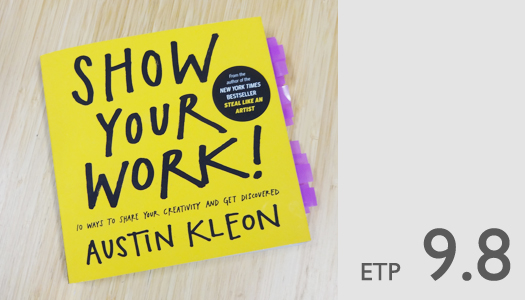Highly recommended book. Watch his TED Talk too.
This is one type of book I very much enjoy to read. Very much to the point with touches of personal revelation. What makes it a great read is the resonation of ideas – there’s no mire of detail (or a need for it) to justify the points he makes. It’s essentially a list of life lessons he feels worth sharing and presents in a takeaway message format. I am going to try to fit several of the things I learned from this book into the YCISL workshop. Note that I also have his book “Steal Like an Artist” and expect I will learn more useful things from that.
Remember that quite a bit of YCISL comes from self-help writings aimed at adults and I try to transfer to a youth context. Here are some of my favorite parts of the book that work with the YCISL program…
– THINK PROCESS, NOT PRODUCT. This is his chapter 2 title and it coincides exactly with how I coach innovation – train for innovation as a process (way of doing things) and not as a product (an outcome that may or may not happen).
–Become a Documentarian of What You Do. In this section, he writes “Write your thoughts down in a notebook, or speak them into an audio recorder. Keep a scrapbook. Take a lot of photographs of your work at different stages in your process.” In YCISL, we promote these ideas through our photo essay and personal journal activities.
–Always be sure to run everything you share with others through The “So What?” Test. I think this is good advice EXCEPT during brainstorming. In brainstorming, treat all ideas as equal and let them all out. It’s like the voice drills of ridiculous noises one might make before singing or making a speech (yes, I’m thinking High School Musical). But get that “So What?” filter running in all the other processes. Use it in prototyping to find the tracks you may want to run on. Use it in testing to empathize with users and anyone else who will be in contact with your product. I will also add that you should use it in user support.
–Every client presentation, every personal essay, every cover letter, every fund-raising request––they’re all pitches. In YCISL, we follow this perspective through our “Your Personal Story” and elevator pitch activities. Not only is there a lot of possible uses for pitches, there is a lesson about readiness and anticipation, an elevated (and hopefully excited) state for ideas and work. In this state, it is waiting for the opportunity to become part of a longer chain of events.
–Teaching people doesn’t subtract value from what you do, it actually adds to it. Teaching doesn’t have to be a career. In a creativity and innovation context, teaching is the core of leadership. It is part of a growth mindset.
– Yet a life of creativity is all about change––moving forward, taking chances, exploring new frontiers. Change isn’t always about moving forward but it is about being willing to be agile and applying divergent thinking to complement logical deductive convergent reasoning. Sometimes, you have to retreat a little to find a strong base (think lessons from Jeff Raskin about citation). Sometimes, you have to look left and right before crossing. And occasionally look behind you. Also, remember the movement pattern within the exploration section of the Gamestorming framework.
Note too that the style of this writing is worth promoting as a YCISL Your Personal Story style in that the personal story is interwoven with snippets from other personal stories.

